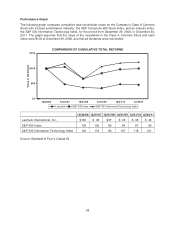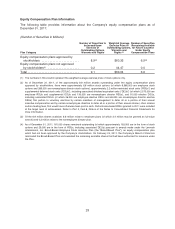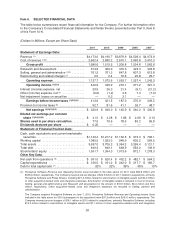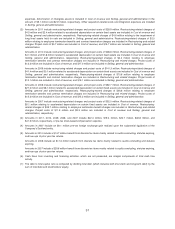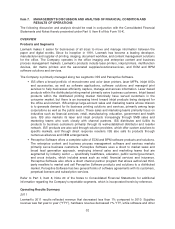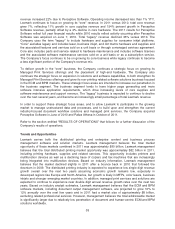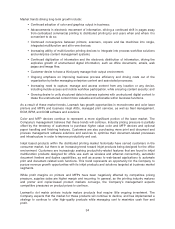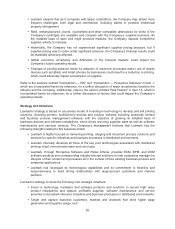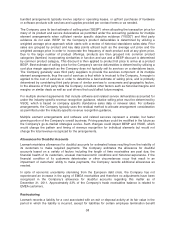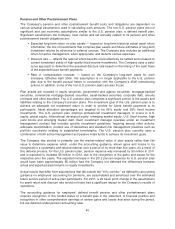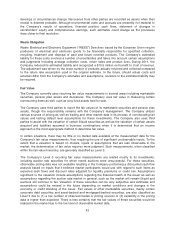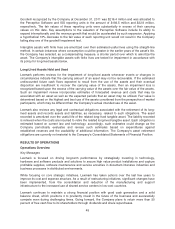Lexmark 2011 Annual Report Download - page 42
Download and view the complete annual report
Please find page 42 of the 2011 Lexmark annual report below. You can navigate through the pages in the report by either clicking on the pages listed below, or by using the keyword search tool below to find specific information within the annual report.bundled arrangements typically involve capital or operating leases, or upfront purchases of hardware
or software products with services and supplies provided per contract terms or as needed.
The Company uses its best estimate of selling price (“BESP”) when allocating the transaction price for
many of its product and service deliverables as permitted under the accounting guidance for multiple
element arrangements when sufficient vendor specific objective evidence (“VSOE”) and third party
evidence do not exist. BESP for the Company’s product deliverables is determined by utilizing a
weighted average price approach which starts with a review of historical standalone sales data. Prior
sales are grouped by product and key data points utilized such as the average unit price and the
weighted average price in order to incorporate the frequency of each product sold at any given price.
Due to the large number of product offerings, products are then grouped into common product
categories (families) incorporating similarities in function and use and a BESP discount is determined
by common product category. This discount is then applied to product list price to arrive at a product
BESP. Best estimate of selling price for the Company’s service deliverables is determined by utilizing a
cost plus margin approach as the Company does not typically sell its services on a standalone basis.
The Company generally uses third party suppliers to provide the services component of its multiple
element arrangements, thus the cost of services is that which is invoiced to the Company. A margin is
applied to the cost of services in order to determine a best estimate of selling price, and is primarily
determined by considering third party prices of similar services to consumers and geographic factors.
In the absence of third party data the Company considers other factors such as historical margins and
margins on similar deals as well as cost drivers that could affect future margins.
For multiple element agreements that include software and related service deliverables accounted for
under the industry-specific revenue recognition guidance, relative selling price must be determined by
VSOE, which is based on company specific standalone sales data or renewal rates. For software
arrangements, the Company typically uses the residual method to allocate arrangement consideration
as permitted under the industry-specific revenue recognition guidance.
Multiple element arrangements and software and related services represent a smaller, but faster
growing portion of the Company’s overall business. Pricing practices could be modified in the future as
the Company’s go-to-market strategies evolve. Such changes could impact BESP and VSOE, which
would change the pattern and timing of revenue recognition for individual elements but would not
change the total revenue recognized for the arrangements.
Allowances for Doubtful Accounts
Lexmark maintains allowances for doubtful accounts for estimated losses resulting from the inability of
its customers to make required payments. The Company estimates the allowance for doubtful
accounts based on a variety of factors including the length of time receivables are past due, the
financial health of its customers, unusual macroeconomic conditions and historical experience. If the
financial condition of its customers deteriorates or other circumstances occur that result in an
impairment of customers’ ability to make payments, the Company records additional allowances as
needed.
In spite of economic uncertainty stemming from the European debt crisis, the Company has not
experienced an increase in the aging of EMEA receivables and therefore no adjustments have been
recognized in the Company’s allowance for doubtful accounts regarding this matter as of
December 31, 2011. Approximately 33% of the Company’s trade receivables balance is related to
EMEA customers.
Restructuring
Lexmark records a liability for a cost associated with an exit or disposal activity at its fair value in the
period in which the liability is incurred, except for liabilities for certain employee termination benefit
38


